No More Comments
I’m sick of dealing with comment spam so I’ve turned comments off.
My email link is at the bottom of each page if you want to get in touch.
I’m sick of dealing with comment spam so I’ve turned comments off.
My email link is at the bottom of each page if you want to get in touch.
Things definitely improved as we progressed through the winter.
December Stats
Monthly Total: 607.1 AH
Daily Average: 19.5 AH
Best Day: 45.5 AH
Worst Day: .2 AH
Days Below 5 AH: 8
January Stats
Monthly Total: 654.1 AH
Daily Average: 21.1 AH
Best Day: 55.1 AH
Worst Day: 0 AH
Days Below 5 AH: 8
February Stats
Monthly Total: 868.8 AH
Daily Average: 31 AH
Best Day: 63.1 AH
Worst Day: 0 AH
Days Below 5 AH: 3
This doesn’t take into account the power from the wind generator. I still don’t have any method of measuring the output of the H80 over time. I can state that we have been generating much more power from the wind generator, we’ve had several days where I am certain that we made more than 100 AH from wind.
We’ve had our first hit of warm weather and the driveway is a mess. If you do not have 4-wheel drive you cannot come and visit. The propane guys tried to come in yesterday, unannounced, I’d have warned them off, and judging by the gouges in the driveway he’s lucky he got back out. I don’t even know how he got in as far as he did, which was only about 100 metres. The benefit is that the worst has passed, most of the snow is off the fields and it can only get better.
On that note I’m also pleased to report that we managed to get in another two equalizes last week due to a full day of both wind and sun. So over the last six months we’ve equalized four times, which from what I can gather is pretty darn good.
Fixing the driveway has now jumped right up to the top of the list, since we don’t want to relive this mess every year. The only way that I can see doing it is to ditch the north (uphill) side of the drive and drop in two or three culverts. That way the melting snow will pass harmlessly under the driveway rather than over it. Then we need to build up the weak spots with another 6-10 inches of gravel. It’s times like these that I’m glad we have our own pit.
Of course none of this can happen until the frost leaves the ground and it is thoroughly dry, which won’t be for another couple of months. Another benefit to the ditching strategy is that the top soil removed by ditching can be spread around the house to build up the landscaping, which also needs to be done this year. Don’t think we’ll be doing any gardening anyway.
This isn’t a post about solar panel azimuth or anything so technical. It’s far more practical advice I’m offering today: if you live in an area that gets a great deal of snow (currently we have between 2 and 3 feet), and you are going to be putting your panels up on your roof, make sure that you have a easy, safe method of clearing snow off of them. Yes the snow will eventually melt off, but I hate losing a full day of sun waiting. Clearing the snow off our panels is a chore that I do not enjoy, climbing the ladder onto the very slippery steel roof and clearing the panels is bad enough, but getting back off the roof and onto the ladder is NOT FUN. The only consolation is that if I fall it will be into four foot deep drifts and onto Gator, who will be trying to catch the falling snow, and will instead get me.
If I were doing it again I would build in a dedicated rest for the top of the ladder that prevented it from sliding sideways. Then I would build a metal catwalk with some angle irons and metal mesh - neither of which is an expensive material. For the sake of a couple of hundred bucks I’d be able to walk around the panels in confidence.
Better yet, if your site allows it, mount the panels on the ground.
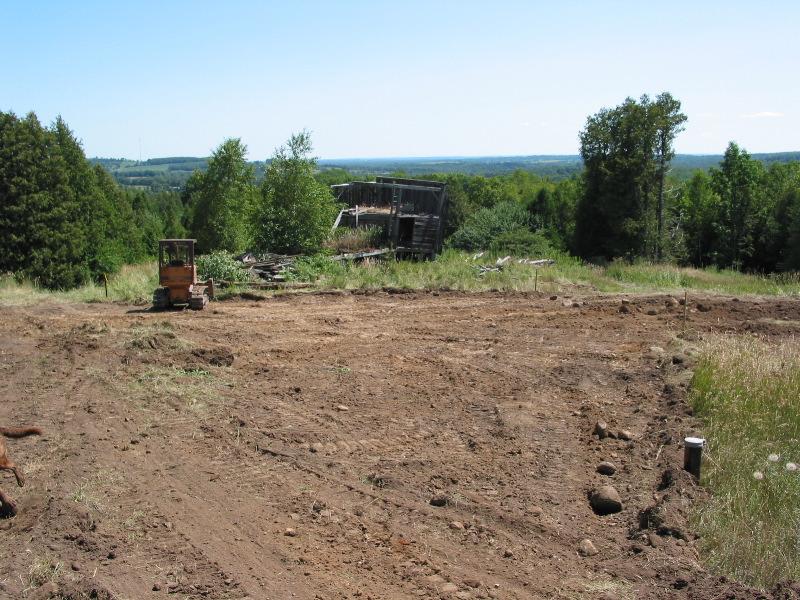
I’ve put together an overview in pictures of the house from the day we broke ground (August 2002) to when we moved in (May 2003).
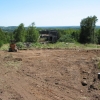
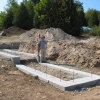
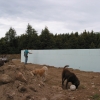

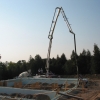

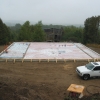
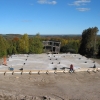
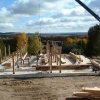
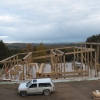
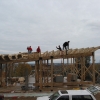
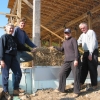
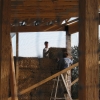
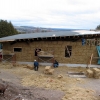
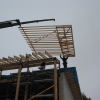
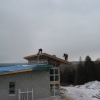
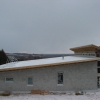


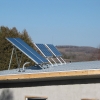
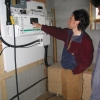

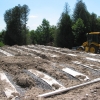
With temperatures dipping down to -30C (-22F) at night (colder with the windchill), we’ve had a pretty frigid couple of weeks. It’s cold enough that the dog’s paws hurt when we go for walks, cold enough that the oil froze in the pipe between my neighbour’s oil tank and his furnace, and cold enough that one of the hoses in our generator froze solid; one of eight the shop had seen that week with the same problem.
So how does the house behave when it’s his cold? Pretty well I’m pleased to report. If the sun is out the front part of the house will get up to 25C (77F) during the day and will hold most of that heat until we go to bed. Of course with the quantity of glass we have across the front of the house we do bleed heat, and the colder it is the faster that heat goes.
If there is no sun though the floor works pretty well. It can hold the house comfortably around 20C-21C (68F-70F), trying to go any higher seems a waste of propane, we just wear sweaters. Because the way radiant floor systems work it’s a ‘slow heat’. The slab is heated to a certain temperature and from there it just radiates (obviously). But we have a huge interior volume of air, much greater than most houses of the same size because we have such high ceilings. At its lowest point our ceiling is over ten feet high, at it’s highest it’s around seventeen. The floor just cannot react fast enough to compensate when the sun goes down. As a result we’ve moved a fireplace up to near top spot on the wish-list. We built a re-enforced pad into the floor to carry the weight of a masonry fireplace but have decided that what we need is actually just an airtight insert or a good woodstove. We need something that can heat the air quickly, but can also stop relatively quickly. The last thing we want is to light a fire on a cloudy morning in a masonry heater, than have the sun come out and have the stove radiating heat all day long. We’d cook ourselves out of the house!
I’ve been running around with the caulking gun sealing cracks and hunting for drafts, and there have been lots. At this point I have gone through more than three dozen tubes of caulking and I have one piece of advice for those building a house: the expensive caulk is worth it! Buy the best stuff you can find, we’ve used various grades around the house and we’ve had all sorts of failures wherever we used cheaper caulk. It might cost more up front but it’s worth it to save the aggravation and cost of having to do the same job twice.
I’ve finished the prototype of the dining room light (pictures here). It’s been hanging for a week now and I’m fairly pleased with the results, though there are some adjustments to be made. Like the gallery lights this fixture uses LED’s. There are four bulbs, each 1 watt, wired with two small power supplies on the ceiling. The drawback to using two power supplies is that I need to run four conductor wire down to the light (which is bulky). The benefit is that all four lights are quite bright.
The body of the light is maple, stained with the dark victorian mahogany stain that we’ve used elsewhere in the house. This matches our dining room table and chairs. The LEDs shine through plastic rod that has plastic tube of the same outside diameter joined to the top. This results in a slight glow from the top sides and a bright glow from the bottom sides. The majority of the light shines down - as is intended. The effect, is very pleasant.
The light hangs from two very thin lines of wire, which are secured for now, with simple plastic screw clips. Once Jo and I have decided on the perfect height for the light I will cut the wire to length and secure it internally (and invisibly).
One of the big problems with the LED bulbs is that the manufacturing process is not perfected at this point. As a result the lights are slightly different colours. They range from a shade of violet-white to a greeny-white. I’ve also had some tinted towards yellow and blue. When the bulbs are made a small amount of phosphure is sprayed onto the inside of the bulb, with the red, orangle, and green bulbs this process is highly tuned, and the colours of those bulbs are very uniform. As it stands right now if I were making these lights commercially I’d have to colour-match all of the bulbs.
I’m going to try another version of the light using plastic for the body. I’m hoping to use blue-tinted plastic so that the light shines down white, but glows outward in a deep blue from the sides. I’m also working on some overheard lights for the ‘bedrooms’, and a couple of other designs for the dining room.
The guys at Eurolite have a whole bunch of brand new prototype LED lights and are getting me a bunch to play with. I can hardly wait.

Some folks have asked how my wind generator deals with high winds. I took some pictures the other day with wind speeds around 35km/h.
Basically there is a angled pivot in the body of the generator. As wind speeds increase the blades are pivoted up at an angle, out of the wind. In the highest possible winds, I imagine, the blades would be parallel to the ground, horizontal rather than vertical.



Bruce Sterling’s annual ‘State of the World’ address/dialogue is up on the Well right now. As always, it makes for great reading.
Since we’re talking about Bruce Sterling I highly recommend that anybody interested in Green Building/Sustainable Living check out the Veridian Design Movement.
And no, I haven’t yet posted that list, and I wouldn’t count on seeing it soon. I do have a working dining room light though, that I will post pictures of real soon, and some other lighting news.
We’ve been here six months now, we’ve gone through our first summer and are headed into our first winter. I was thinking last week, as I walked across the fields to get my mail, how much I’m really enjoying living in the country. Joanne and I have a knack for choosing good locations, our first house was on a really fantastic street in downtown Toronto, with amazing neighbours, and all that downtown has to offer. Good and bad. It looks like we’ve lucked into a great neighbourhood once again.
Last Saturday was the neighbourhood Christmas party. Every year everybody on the Line gets together at one house to celebrate the season. Everyone brings a little something to add to the table, some booze, and this year, a sealed envelope with a contribution for a young boy on the line who has cancer and is going through chemo.
This is an adult affair, though an exception was made for Gil, since he’s so young. As soon as we walked in the door Gil had been wisked out of my arms and I hardly saw him for two hours, though you could follow his progress around the room by all the cooing of the women. He slept through the whole thing. Midway through the night my next door neighbour and I slipped out and went to play hockey in Millbrook. When we came back two hours later the party was still going on.
Hockey in Millbrook is a quintessentially Canadian affair. Pick-up hockey, played on a small-town rink with a bunch of guys of various skill levels in various levels of equipment, with either classic rock or country playing at ear-splitting levels over the PA system. I step on the ice and I feel like singing Oh Canada. We rarely have enough players (or goalies), there are no lines, no positions, and nobody seems to keep score, it really is hockey played for the sheer joy of it.
I’ve been composing a list of things I love and ... er ... like less about the country. I’ll post it soon. Right now there’s about 6 inches of snow on the ground, it’s minus 10C, and the whole countryside looks like a Christmas card. I love winter in the country - that’s number one!